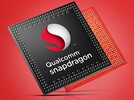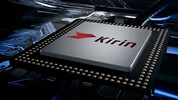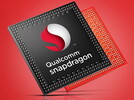Qualcomm Snapdragon 415 MSM8929 vs HiSilicon Kirin 9000W vs Qualcomm Snapdragon 615 MSM8939
Qualcomm Snapdragon 415 MSM8929
► remove from comparison
The Qualcomm Snapdragon 415 (8929) is an ARM-based mid-range SoC for tablets and smartphones (mostly Android based). It was announced in February 2015 and integrates eight 64-Bit Cortex-A53 CPU cores (octa-core) that clock with up to 1.4 GHz. Furthermore, there is a Adreno 405 graphics card, a LPDDR3 memory controller (max. 667 MHz, 5.3 GB/s) and wireless radios for WiFi and 4G/LTE included in the chip.
The Cortex-A53 is the successor of the entry level Cortex-A7 CPU cores. The A53 is now capable of 64 Bit (ARMv8-ISA) and adressing more than 4 GB RAM. According to ARM the performance per MHz is a lot better and even surpasses a Cortex-A9 core.
The integrated Adreno 405 is clocked with about 500 MHz and supports DirectX 11.1 incl. hardware Tesselation, OpenGL ES 3.1 and OpenCL 1.2.
The integrated wireless radios support WiFi 802.11ac, Bluetooth 4.1, GPS, 2G, 3G and 4G (LTE Cat.4) standards. Futhermore, the SoC is able to decode 1080p videos in H.265 (encode only in H.264) and cameras with up to 13 MP.
The power consumption of the chip is ranging in the mid range, and therefore it is also suited for smaller smartphones.
HiSilicon Kirin 9000W
► remove from comparison
The HiSilicon Kirin 9000W is an SoC that can be used in smartphones and tablets based on Android and was first installed in the Huawei MatePad Pro 13.2.
Huawei does not reveal any information about the SoC. The little information that is available comes from benchmarks and system analysis tools. The CPU consists of three clusters with a total of 12 cores. The power-saving cluster has four ARM Cortex-A510 cores, each operating at up to 1,530 MHz, while six other cores use unspecified cores from HiSilicon (0x0D42) and clock at up to 2,150 MHz. The third cluster contains two HiSilicon cores (0x0D02), each with a maximum clock speed of 2,487 MHz. The performance cores could possibly be based on the TaiShan V120 architecture (as in the Kirin 9000S).
The single-core performance is correspondingly mixed, but the multi-core performance is at the level of a high-end SoC from 2022 due to the numerous cores.
A Maleoon 910 by HiSilicon is integrated as the graphics unit, similar to the 9000S (where it was clocked with up to 750MHz).
Nothing concrete is known about the manufacturing process or the architecture. The SoC will probably be manufactured in 7 nm at SMIC.
Qualcomm Snapdragon 615 MSM8939
► remove from comparison
The Qualcomm Snapdragon 615 MSM8939 is a mid-range ARMv8-based SoC largely for Android tablets and smartphones. Announced in February 2014, the S615 is one of the first 64-bit capable SoCs from Qualcomm. In addition to 8 Cortex-A53 CPU cores at up to 1.7 GHz, the SoC integrates an Adreno 405 GPU with a 2x 32-bit memory controller (LPDDR3-1600, 12.8 GB/s) and supports Wi-Fi (802.11ac), Bluetooth 4.0, UMTS, and LTE.
CPU
The Cortex-A53 is the successor to the very popular Cortex-A7 design. In addition to the new 64-bit capable ARMv8 ISA, the cores offer a variety of other improvements such as better branch prediction. This leads to a significantly higher performance per clock, which is even above the older Cortex-A9.
The eight cores of the Snapdragon 615 are divided into two quad-core clusters, each optimized for a different operating point. While one cluster can clock up to 1.7 GHz to handle more demanding applications, the other cluster is limited to a maximum of 1.0 GHz for energy-saving purposes. All eight cores can be active at the same time, although most applications aren't parallelized to support 8 cores efficiently.
Overall, the Snapdragon 615 offers a performance similar to that of the older Snapdragon 600 (Krait architecture).
GPU
Another new feature is the integrated graphics unit named Adreno 405 (550 MHz). The Adreno 400 series has been substantially redesigned and supports DirectX 11.2 (FL 11_1) including hardware tessellation, OpenGL ES 3.1, and OpenCL 1.2. Furthermore, the performance has been significantly improved, which is now similar to the Adreno 320 and PowerVR G6200.
Features
The Snapdragon 615 offers numerous wireless technologies such as Bluetooth 4.0 and WLAN 802.11a/b/g/n/ac as well as a Multi-SIM cellular modem supporting LTE cat. 4 (up to 150 Mbps), WCDMA, CDMA, EV-DO, TD-SCDMA and GSM/EDGE.
The SoC can encode and decode 1080p videos using dedicated hardware and stream content to displays with up to 2560 x 2048 pixels. A large number of video codecs including H.265 (playback only) will be supported. The camera ISP can handle sensors with up to 21 MP.
Power Consumption
The Snapdragon 615 is manufactured by TSMC in a 28 nm LP process. According to the specifications, we expect a medium or medium-high power consumption for use in medium-sized or larger smartphones and tablets.
| Model | Qualcomm Snapdragon 415 MSM8929 | HiSilicon Kirin 9000W | Qualcomm Snapdragon 615 MSM8939 | ||||||||||||||||||||||||||||||||||||||||||||||||||||||||||||||||||||||||||||||||||||||||||||||||||||||||||||||||||||||||||||||||||||||||||||||||||||||||||||||||||||||||||||||||||||||||||||||||||||||||||||
| Series | Qualcomm Snapdragon | Qualcomm Snapdragon | |||||||||||||||||||||||||||||||||||||||||||||||||||||||||||||||||||||||||||||||||||||||||||||||||||||||||||||||||||||||||||||||||||||||||||||||||||||||||||||||||||||||||||||||||||||||||||||||||||||||||||||
| Codename | Cortex-A53 | Cortex-A53 | |||||||||||||||||||||||||||||||||||||||||||||||||||||||||||||||||||||||||||||||||||||||||||||||||||||||||||||||||||||||||||||||||||||||||||||||||||||||||||||||||||||||||||||||||||||||||||||||||||||||||||||
| Series: Snapdragon Cortex-A53 |
|
|
| ||||||||||||||||||||||||||||||||||||||||||||||||||||||||||||||||||||||||||||||||||||||||||||||||||||||||||||||||||||||||||||||||||||||||||||||||||||||||||||||||||||||||||||||||||||||||||||||||||||||||||||
| Clock | 1400 MHz | 1530 - 2490 MHz | 1700 MHz | ||||||||||||||||||||||||||||||||||||||||||||||||||||||||||||||||||||||||||||||||||||||||||||||||||||||||||||||||||||||||||||||||||||||||||||||||||||||||||||||||||||||||||||||||||||||||||||||||||||||||||||
| Cores / Threads | 8 / 8 | 12 / 12 2 x 2.5 GHz 6 x 2.2 GHz 4 x 1.5 GHz ARM Cortex-A510 | 8 / 8 | ||||||||||||||||||||||||||||||||||||||||||||||||||||||||||||||||||||||||||||||||||||||||||||||||||||||||||||||||||||||||||||||||||||||||||||||||||||||||||||||||||||||||||||||||||||||||||||||||||||||||||||
| Technology | 28 nm | 7 nm | 28 nm | ||||||||||||||||||||||||||||||||||||||||||||||||||||||||||||||||||||||||||||||||||||||||||||||||||||||||||||||||||||||||||||||||||||||||||||||||||||||||||||||||||||||||||||||||||||||||||||||||||||||||||||
| Features | Adreno 405 GPU, WLAN 802.11ac, Bluetooth 4.1, GSM/EDGE, WCDMA, UMTS/HSPA, LTE Cat. 4 (max. 150 Mbps), GPS (Qualcomm IZat Gen8C Lite), LPDDR3-1333 Memory Controller | Adreno 405 GPU, 802.11ac WLAN, Bluetooth, LTE, NFC, GPS/GLOSNASS/BeiDou, 32/64 Bit LPDDR3 Memory Controller | |||||||||||||||||||||||||||||||||||||||||||||||||||||||||||||||||||||||||||||||||||||||||||||||||||||||||||||||||||||||||||||||||||||||||||||||||||||||||||||||||||||||||||||||||||||||||||||||||||||||||||||
| iGPU | Qualcomm Adreno 405 | HiSilicon Maleoon 910 | Qualcomm Adreno 405 ( - 550 MHz) | ||||||||||||||||||||||||||||||||||||||||||||||||||||||||||||||||||||||||||||||||||||||||||||||||||||||||||||||||||||||||||||||||||||||||||||||||||||||||||||||||||||||||||||||||||||||||||||||||||||||||||||
| Architecture | ARM | ARM | ARM | ||||||||||||||||||||||||||||||||||||||||||||||||||||||||||||||||||||||||||||||||||||||||||||||||||||||||||||||||||||||||||||||||||||||||||||||||||||||||||||||||||||||||||||||||||||||||||||||||||||||||||||
| Announced | |||||||||||||||||||||||||||||||||||||||||||||||||||||||||||||||||||||||||||||||||||||||||||||||||||||||||||||||||||||||||||||||||||||||||||||||||||||||||||||||||||||||||||||||||||||||||||||||||||||||||||||||
| Manufacturer | www.qualcomm.com | www.qualcomm.com |


 Deutsch
Deutsch English
English Español
Español Français
Français Italiano
Italiano Nederlands
Nederlands Polski
Polski Português
Português Русский
Русский Türkçe
Türkçe Svenska
Svenska Chinese
Chinese Magyar
Magyar
